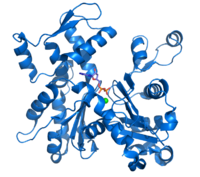
Photo from wikipedia
Fibrosis is a physiological process of tissue repair that turns into pathological when becomes chronic, damaging the functional structure of the tissue. In this review we outline the current status… Click to show full abstract
Fibrosis is a physiological process of tissue repair that turns into pathological when becomes chronic, damaging the functional structure of the tissue. In this review we outline the current status of extracellular vesicles as modulators of the fibrotic process at different levels. In adipose tissue, extracellular vesicles mediate the intercellular communication not only between adipocytes, but also between adipocytes and other cells of the stromal vascular fraction. Thus, they could be altering essential processes for the functionality of adipose tissue, such as adipocyte hypertrophy/hyperplasia, tissue plasticity, adipogenesis and/or inflammation, and ultimately trigger fibrosis. This process is particularly important in obesity, and may eventually, influence the development of obesity-associated alterations. In this regard, obesity is now recognized as an independent risk factor for the development of chronic kidney disease, although the role of extracellular vesicles in this connection has not been explored so far. Nonetheless, the role of extracellular vesicles in the onset and progression of renal fibrosis has been highlighted due to the critical role of fibrosis as a common feature of kidney diseases. In fact, the content of extracellular vesicles disturbs cellular signaling cascades involved in fibrosis in virtually all types of renal cells. What is certain is that the study of extracellular vesicles is complex, as their isolation and manipulation is still difficult to reproduce, which complicates the overview of their physiopathological effects. Nevertheless, new strategies have been developed to exploit the potential of extracellular vesicles and their cargo, both as biomarkers and as therapeutic tools to prevent the progression of fibrosis towards an irreversible event.
Journal Title: European journal of cell biology
Year Published: 2022
Link to full text (if available)
Share on Social Media: Sign Up to like & get
recommendations!